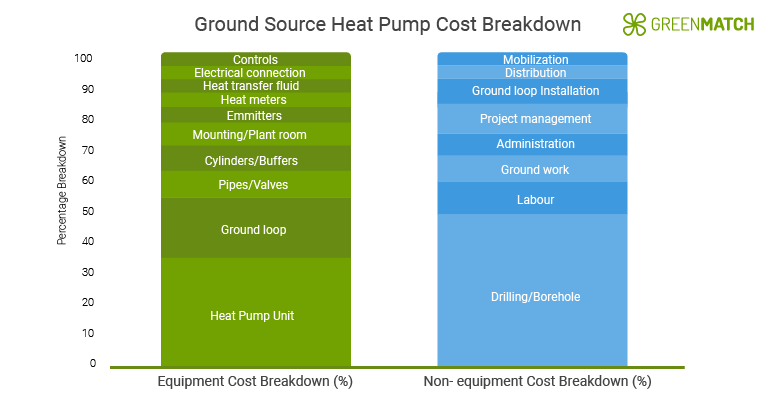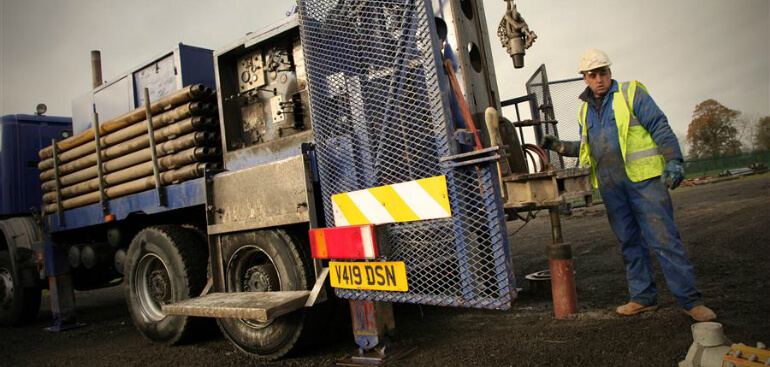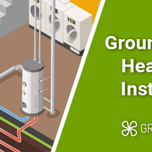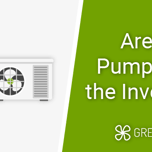
Get up to 4 quotes by filling in only 1 quick form

Slash your energy bills by installing a heat pump

We’ve helped over 500,000 homeowners reduce their carbon footprint
- GreenMatch
- Ground Source Heat Pumps
- Ground Source Heat Pump Prices
Ground Source Heat Pump Prices

Ground source heat pumps (GSHPs) are a popular and sustainable alternative to traditional heating and cooling systems as they transfer heat from the ground rather than generating it by burning fossil fuels for instance.
The cost of a GSHP will depend on a number of factors, such as the type of system you choose, the size of the property, and the local installation costs. Throughout this article, we’ll explore the prices for ground source heat pumps and what factors determine their costs and advantages.
Despite the lower energy bills given their energy efficiency and no need for fuel, they are expensive to install, however, they can save homeowners money in the long term by cutting heating and cooling costs. Once installed, a new ground source heat pump provides renewable heat all year long. To help overcome the steep upfront costs, it’s important to ensure you are paying the most fair and accurate prices for installation.
This is where GreenMatch can help you. By filling in the simple form (linked below) we can match you with up to 3 professional heat pump installers, all of them local to your area. Local installers mean local rates, allowing you to avoid the delivery of parts and labour from a nationwide company.
Get started by clicking the button below. All of our quotes come free with no obligation.
- Quotes from local engineers
- Payment by finance available
- Save up to £1100 per year
It only takes 30 seconds



How Much Do Ground Source Heat Pumps Cost in the UK?
Ground source heat pumps are highly efficient, renewable heating systems which will continue to play a significant role in the UK’s transition to a low-carbon economy.
Ground source heat pump costs will differ from one project to another. The average ground source heat pump prices and installation costs range from £14,500 to £45,000.
The price would naturally vary depending on the system you select. There are two types of ground source heat pumps, and generally speaking, a horizontal system is cheaper than boreholes, as specialised equipment is not required.
Ground source heat pumps (GSHP) are widely known as environmentally-friendly investments that can help you save between £195 – £670 per year on your heating bill when replacing a standard gas boiler, depending on your heating demands.
Through the UK Government’s Boiler Upgrade Scheme, and similar grants for ground source heat pumps, eligible homes can also save significantly on installation costs.
How Is the Total Price Determined?
The ground source heat pump prices vary on a range of factors, from the system design, the dwelling, and your energy use. The following key factors all affect how the total price is determined:
- The size of the dwelling and its insulation level
- The size of the heat pump system
- The existing radiators or underfloor heating system
- If it’s a vertical or horizontal system
The heat pump installer will design a heat pump system based on the dwelling’s level of heat loss, the level of energy consumption, the soil type of the property, and the domestic hot water requirements. This will help in choosing the accurate size of the heat pump and piping system design.
A well-insulated house will require a smaller heat pump and a smaller ground loop system, and therefore will be less pricey.
In addition, the conditions of existing radiators or underfloor heating systems can affect the overall installation cost. If they are suboptimal, they may need to be replaced with new equipment entirely and this can increase the costs significantly. For this reason, GSHPs are typically more suited to new-builds rather than retrofits.
What Are the Installation Costs?
During the ground source heat pump installation, the piping for the ground heat exchanger may be laid in horizontal trenches if space is available, or in vertical boreholes if there is a limited amount of space.
Ground source heat pump costs and installation prices are generally higher compared to an air source heating system. For example, the price to install an air to water heat pump ranges from £8,000 to £18,000, while the total GSHP price including installation should range between £14,500 – £45,000.
Even if the ground source heat pump cost might place a strain on your budget, you still may save a great deal of money by ensuring your house is properly insulated. This will cut down the heating system operational costs, as well as reduce the capital cost, given that the capacity of the ground source heat pump, or the size of the ground collectors, can be scaled down in line with the reduced heating load.
However, it is important to evaluate the long-term value of this investment. The running costs of a heat pump, such as a ground source heat pump, are lower compared to other renewable heating systems. Once installed, the ground source heat pump piping system has an estimated lifespan of 50-100 years, while the heat pump itself can run for 20-25 years. Finally, ground source heat pumps require low maintenance after installation.
The table below outlines rough price estimates of vertical and horizontal GSHP systems.
| Number of bedrooms | Capacity of GSHP (kW) | Price of heat pump and installation | Price of Horizontal Groundwork | Price of Vertical Ground |
|---|---|---|---|---|
| 3 | 11 kW | £21,000 | £3,750 | £15,000 (3 vertical boreholes) |
Since the upfront investment for a new ground source heat pump can be very high, it becomes all the more important that you choose a reliable, qualified installer. Doing so, ensures your system runs as efficiently as possible, according to your home’s unique specifications.
What’s more, a trustworthy installer will also offer the most fair and accurate prices for installation. Finding such installers is not always easy. That’s why we recommend comparing quotes from multiple installers before you make your choice.
This is where GreenMatch can help you! By filling in our quick and easy form, you can be matched with up to 3 installers, who will assess your home’s suitability, and offer a quote for their installation services.
All of the installers in our wide network are licensed and we can connect you with those closest to your area. This allows you to take advantage of the best local deals, rather than overpaying for the delivery of parts and labour from a nationwide company.
- Quotes from local engineers
- Payment by finance available
- Save up to £1100 per year
It only takes 30 seconds



Price Breakdown: Equipment vs. Non-Equipment Costs
In a report by the Department of Energy and Climate Change, an illustration of the ground source heat pump price structure was developed.
The illustration considers a 90 kW ground source heat pump as a base case for scoping the equipment vs. non-equipment price breakdown. This example is used to also compare smaller projects and larger-scale project costs.
The non-equipment prices for a 90 kW retrofit ground source heat pump are slightly higher than the equipment price, mainly due to the drilling, boreholes, and groundwork (~60% of this cost) as well as the added complexity in the design and specification process.

As you can see in the figure above, 51% of the total price of ground source heat pump installation is non-equipment costs, of which 60% is the price of drilling and groundwork. The price of the heat pump itself and complementary equipment accounts for 49% of the total ground source heat pump price.
Below is a detailed breakdown of the ground source heat pump installation cost in the UK.

Source of cost breakdown: Department of Energy and Climate Change, 2016
Considering smaller ground source heat pump installations, let’s say 12 kW system, the overall price will be approximately 10-20% per kW higher than the 90 kW system.
The ground source heat pump price per kW will be higher than for 90 kW in this case because many of the same parts, such as sensors & transducers, are used in a smaller system as in a large one – but are then proportionally a larger part of the total price.
Additionally, in the case of ground source heat pump borehole cost for installation, the price per metre of groundwork for the 12 kW system will also be higher than for a 90 kW system. This is because the costs to start up the drilling are the same whether for a small or large ground source heat pump installation. However, the costs of the groundwork needed for installing horizontal trenches is lower than for boreholes.
In the case of larger ground source heat pump installations, let’s say 600 kW system, the overall price will be approximately 15% per kW higher than the 90 kW system. The split between equipment/non–equipment cost is 45:55 in this case.
In larger ground source heat pump installations (i.e., above ~250 kW), the non-equipment price will include groundworks (including drilling), design, project management, commissioning, and labour.
To learn how your home suits a ground source heat pump, whether you will require a vertical or horizontal system, and for tailored cost breakdowns, we recommend seeking the advice of a professional heat pump installer.
Use GreenMatch’s free quotes service to be connected with up to 3 installers, each of them licensed, and matched to you based on your home’s specifications. By comparing their quotes, you can make your choice based on the most competitive price.
Get started today by clicking the button below. All our quotes are free and come with no obligation.
- Quotes from local engineers
- Payment by finance available
- Save up to £1100 per year
It only takes 30 seconds



What Are Excavation and Borehole Costs?
The ground source heat pump cost of installation is high due to the expensive excavation work required. To install the heat pump loops, deep trenches or vertical boreholes need to be dug.
The heat pump loops are buried either horizontally in a shallow trench (at a depth of 1.0m – 2.0m) or vertically in a borehole that can be 50m-150m deep.
The ground source heat pump cost for drilling and lining a borehole might range from £60 to £100 per metre, depending on the local geology.
If the ground source heat pump system design requires the installation of a vertical loop system, one or several boreholes need to be installed. The total costs of the ground work and borehole installation depend on the following factors:
- The borehole depth.
- The underlying geology and hydrogeology of the site.
- The design and construction method of the borehole.
- The proposed location of the borehole on the site.
- The borehole pipes diameter.
- The borehole fitting materials.
- The type, make and model of the heat pump selected.

How Much Can You Save on Bills with a GSHP?
According to the UK’s Energy Saving Trust, the extent of savings on your heating bills will depend on which heating system you are switching from. Hence, your savings will be affected by:
- The heat distribution system you will be using
- The costs of fuels you are replacing
- Replacing an outdated heating system with a new and more efficient one
- The way you operate the heat pump
Below we present the savings you can expect to get by replacing an old heating system with a new ground source heat pump system in an average 4-bedroom detached house.
| Existing system | Fuel bill savings (£/year) | Carbon dioxide savings (kg CO2/year) |
|---|---|---|
| Gas boiler | £195 – £670 | 1,900 – 2,800 kg |
| Electric | £950 – £1,600 | 1,500 – 2,100 kg |
| Oil boiler (noncondensing) | -£60 – £375 | 2,900 – 4,400 kg |
| LPG boiler | £350 – £860 | 2,200 – 3,300 kg |
| Coal | £800 | 7,000 kg |
Source: UK Energy Saving Trust
| Existing system | Fuel bill savings (£/year) | Carbon dioxide savings (kg CO2/year) |
|---|---|---|
| Gas older (noncondensing) | £900 – £1,500 | 1,700 – 2,700 kg |
| Electric (old storage heaters) | £360 – £630 | 1,800 – 2,500 kg |
| Oil older (noncondensing) | £600 – £1,000 | 2,800 – 4,200 kg |
| LPG older (noncondensing) | £920 – £1,400 | 2,800 – 3,100 kg |
| Coal | £980 | 7,000 kg |
Source: UK Energy Saving Trust
Ofgem introduced new customer protection regulations on 15 December 2020 that will support customers that are struggling to pay for their energy bills.
The regulations will protect those that are vulnerable and temporarily unable to pay their energy bills in the form of more appropriate credit management policies and sustainable repayment plans.
Is A Ground Source Heat Pump Worth It?
If a ground source heat pump is installed properly, is tailored to your home, and you have done you maintain it regularly, then it is worth its investment.
The International Energy Agency, in their latest special report, stresses that no new gas boilers should be sold after 2025 if Net Zero targets need to be achieved by 2050. Heat pumps are expected to be a better, low-carbon alternative to heating homes in the foreseeable future.
To ensure you get the most out of your ground source heat pump, there are a few considerations you must address. Though there are numerous benefits to having a ground source heat pump, if you install the wrong system size or the installer does not carry out a good job, you will end up paying far more for your system than you should.

Finding the right installer for your new installation is crucial to ensure you heat pump runs efficiently. To be connected to up to 3 installers for you to choose between, fill in a few simple details in the form (linked below).
By doing so, you can take advantage of several benefits:
- Save time and effort finding installers yourself. Instead we will match and connect installers to you, based on the details provided.
- All of our quotes come free and with no obligation, from qualified installers.
- Local installers mean local rates. We will match you with installers based in and around your local, meaning you can avoid paying for the delivery of parts and labour from a nationwide company.
- Find the best deal. Compare the tailored quotes you receive until you land on the most competitive price.
Get started today by clicking the button below!
- Quotes from local engineers
- Payment by finance available
- Save up to £1100 per year
It only takes 30 seconds




Attila is the UX Manager at GreenMatch. He holds a degree in international business with four years of coordination experience in marketing, user experience, and content creation. Attila likes to write about solar energy, heating technology, environmental protection, and sustainability. His and his team’s articles appeared in well-known sites such as The Conversation, Earth911, EcoWatch, and Gizmodo.
 We strive to connect our customers with the right product and supplier. Would you like to be part of GreenMatch?
We strive to connect our customers with the right product and supplier. Would you like to be part of GreenMatch? 




